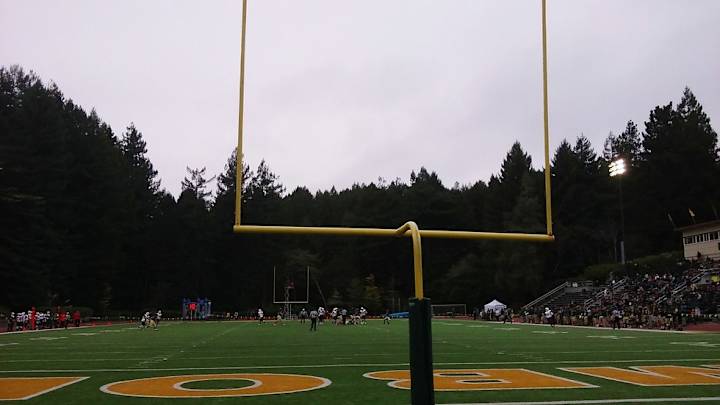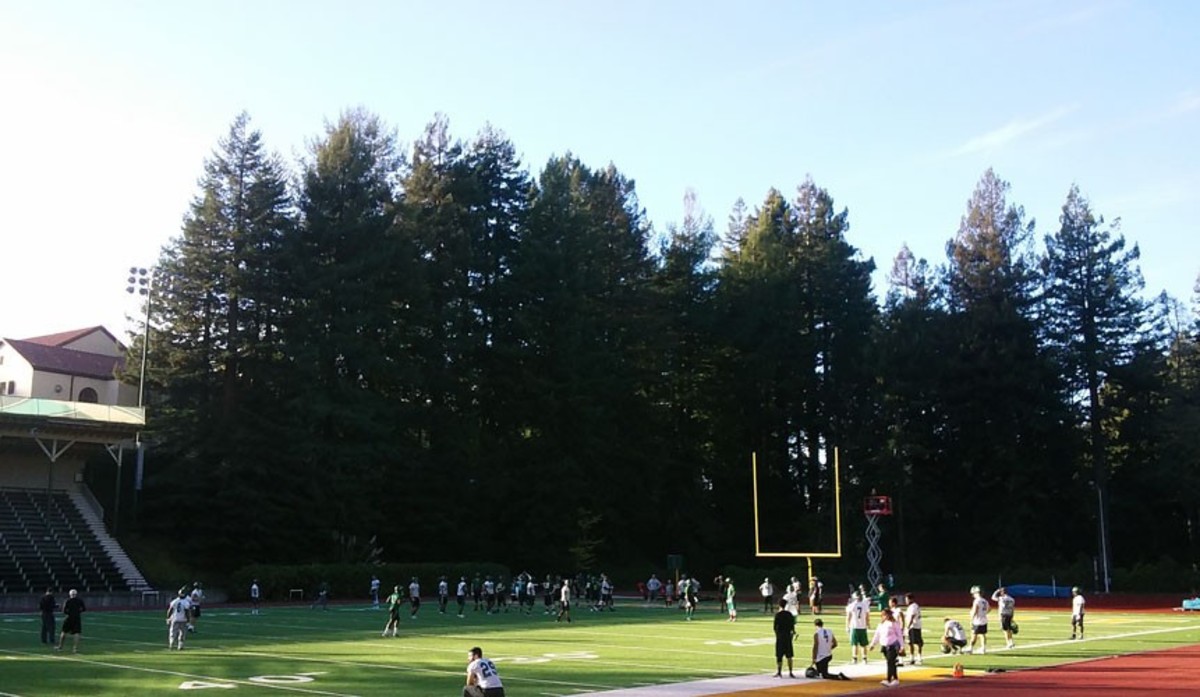Welcome to Humboldt State, a place with a very good football team but is known for something else

[video:http://bcove.me/8n8rzr7j]
ARCATA, Calif.—If the NCAA required college mascots to reflect a school's physical surroundings or culture, or at least what drives the local economy, then San Diego State might be forced to drop Aztecs in favor of Smugglers, Oklahoma would drop Sooners for Frackers, and Humboldt State would be the Weed Farmers instead of the Lumberjacks.
After all, the timber industry began dying here in the '60s, such that a recent ride in a two-man prop plane over Humboldt County—a sparsely populated, 4,000–square-mile swath of forest in northern California—revealed abandoned lumber mills on the shores of parched rivers. Surrounding these scenes of desolation, however, was a stunning abundance.
The tallest living things in the world grow here—coast redwoods that reach higher in length than a football field and wider at their base than a first down. From the air, the only visual interruptions in this rumpled carpet of sequoia sempervirens were the low, bushy fields and stark white greenhouses where the most plentiful and potent marijuana harvests in the world are grown—some of them startlingly close to Redwood Bowl, home of the Division II Humboldt State Lumberjacks.
Entering the 7,000–seat stadium through the west tunnel is like entering a movie pitch for
Friday Night Lights meets Apocalypse Now. Redwoods surround the gridiron like sentries; some of them so close that an errant spiral can chip bark off the endangered giants. Imagine a patch of field turf appearing in the rainforest where the Ewoks zoomed their speeder bikes in Return of the Jedi (a scene that was shot in a nearby redwood grove 33 years ago.) "When the fog rolls in on a Saturday night," all-conference receiver Chase Krivashei says of Redwood Bowl, "it feels like a sacred place."
The Lumberjacks went undefeated this season at their consecrated home field, which can turn unholy for opponents when 8,000 fans are screaming in the woods. This home-field advantage ticked upward in '09, Rob Smith's second season as head coach, when, as he remembers it: "We scored against Central Washington, and this guy—to this day I don't know who he was—stands up in the top row of the home side, whips out a chainsaw, and fires that sucker up. How he got that through our security, I don't know, but every head in the joint turned."
The guy was Tony Gomez. He was an Humboldt State Forestry student, like the five chainsaw handlers who are carrying on the tradition at this year's Halloween game against Simon Fraser University, waiting for a Lumberjack touchdown or turnover so they could yank the start ropes on their Stihls and wave the whirring power tools overhead. "I did it on a dare," Gomez recalls of his mission six years ago. "Just walked right in. Had a full tank of gas in it. Nobody said anything … When I fired it up, all I saw were eyeballs. I just thought, 'Well, I can't hide.' So I squeezed the throttle a few times."
"My first reaction," Smith remembers, "was,
Holy s---! The second thing was, Y'know what, that's pretty cool … Since then, it's kind of become our thing, it's what we're known for."
Well, not exactly.
Walk through the Art Quad on a weekday afternoon and you'll smell what Humboldt State is known for. Or stop by the Saturday farmers market at Arcata Plaza, the college town's central square, where smoking tobacco can get you a police citation but sparking up a joint won't earn you a second glance. Or ask the bearded guy holding a chainsaw beneath the west goalpost, the guy in the sleeveless denim dress. Humboldt State senior George Menges is dressed as a "Humboldt Honey" for Halloween, local slang for the expensively-outfitted girlfriends of the county's millionaire weed growers. Menges doesn't smoke—his costume selection was emboldened by a nip of Irish coffee—so it is with heightened reliability that he assures you of what a half dozen other fans will tell you in between plays on this day: "Humboldt weed is an international brand. It's what people do here."
Humboldt County sheriff Mike Downey put it this way: "Chico State (four hours south) is known as one of the biggest party schools in the country. Humboldt State is known as the place where you get your weed. It's not something you can just change."
*****
[video:http://bcove.me/v9xkg21q]
This is a rare day game at Redwood Bowl because of the evening's Halloween festivities, so the crowd is about half its normal size. This aberration will not halt Humboldt's seven-year streak of leading the Great Northwest Athletic Conference (GNAC) in attendance. The Saturday night faithful and their scenic stadium, sunk in the woods of the planet Endor, are but two of the enticements for high school players who have one glaring shortcoming (usually lack of size or exposure) yet want to play college ball.
Says Smith, "We tell our recruits: Find me another place where you can stand on the 50–yard line and in five minutes you can either be hanging out at the beach or hiking in the redwoods."
As for the billion-dollar cash crop that grows in the shade of those trees, "We address it head–on," says Smith, who gave Stanford coach David Shaw his first job back in '95, coaching linebackers at Western Washington. "When I meet with recruits and their parents, I ask them, 'What's the reputation of Humboldt State? Bunch of pot-smoking hippies, right? I thought the same thing when I was thinking about taking this job and moving my family here. I had two kids—one entering high school and one entering middle school.' So I let [recruits] know: 'Yes, that element is here. If you're looking for it, you can find it. But that's not who we are.' I'd love to say we're 100% clean. That's probably not true. I can tell you that it's an issue I very rarely have to deal with."
No, the herb known for creating distractions has not been a distraction for the Lumberjacks, as evidenced by the once-in-a-lifetime season they put together this fall. Three weeks after this Halloween win, Humboldt State would host a Division II playoff game (where no chainsaws were allowed, per NCAA rules) for the first time since 1968. (That's the year, incidentally, that the county morphed from a wood- and fish-producing shire to a refuge for pot-growing Frisco hippies). They got there by recruiting players like Krivashei, the 5' 9", 170-pound wideout who was all-state at Corona Centennial High, one of the elite programs in southern California.
Because of Krivashei's size, Humboldt was the only school that showed him serious interest. Upon signing with the Jacks, he was rewarded with a winless (0–11) freshman campaign in '13. So he texted his high school quarterback, Robert Webber, who was one year younger and also 5' 9".
Webber, who'd been ignored by D–I schools despite 8,200 passing yards and 85 TDs at Centennial, received Krivashei's two-word text during his only official visit, to FCS Murray State:
Yo. Don't.
"Humboldt isn't close to home," says the strong-armed Webber, who became the starter as a true freshman last fall and has led the Lumberjacks to an 18–4 record since, "but it is in California. My parents come to every home game." His choice made what would have been a 28-hour drive to Murray, Kent., into a quick drive up the coast that takes a mere … 12 hours?
"We use the isolation of this place to our advantage," says Smith.
The Jacks aren't just the only show in town, they're the only show in the nine driving hours and 19 rural counties that separate Berkeley from Eugene, Ore. This private loudness—a massive redwood whose falling goes unheard—helps create what senior linebacker Taylor Mitchell calls "the best setting in D-II football, period."
But it does have its drawbacks. Smith estimates that no other college team spends as much time on the road. Not even the University of Hawaii, whose football team flies to its games on the mainland. Humboldt travels mainly by bus to away games in South Dakota, British Columbia and Texas. They depart on Thursday mornings. No other college football team does this. No other team has to.
Josh Hanson of nearby Eureka High (the alma mater of Bengals linebacker Rey Maualuga) arrived at Humboldt as a 210–pound sprinter and today is an all-conference guard who checks in at 290. "It helps that we're so far from other teams," he says. "What are you gonna be, a Cal fan? Everyone here seems to care how this team is doing."
"It's electric," says Ja'Quan Gardner, a 5' 7", otherwise unrecruited running back who rushed for a Division II–best 2,266 yards this season. "This place isn't like anywhere else."
Two touchdowns each from Gardner and Krivashei have helped Humboldt build a 35-0 halftime lead on this cloudy Halloween, but the player with the best chance of landing on an NFL roster someday is a left tackle who arrived here as a spindly high school catcher from the Bay Area suburbs. Alex Cappa spent his redshirt year at Humboldt with highly regarded strength coach Drew Peterson (who doubles as the Jacks' P.A. announcer; budgets are tight in D-II) and emerged a 6' 7", 290-pound leviathan who opens holes big enough for five Ja'Quan Gardners to run through.
"That's why this team is so tight," says Cappa, sweeping his sweaty, chest-length hair off his shoulder pads after practice. "No one else wanted us, so we came up here and said, 'Y'know what?'"—he glances around at a forest that predates Genghis Khan—"'This is good with me.'"

Michael McKnight/SI
"The big programs decided, 'These guys don't fit our mold,'" says Smith. "Well, we don't have a mold."
Just as Humboldt's remoteness affords an unlikely recruiting advantage, it also gives black-market marijuana farmers plenty of room to ply their trade in the hills. According to the Eureka Times Standard, "approximately one-fifth of [Humboldt County's] population is involved in growing and/or trimming pot." You're reminded of this stat at halftime, when the student body (17% of whom grew up working in the industry, according to one HSU study) marches into the surrounding forest and returns for the third quarter smelling like Future's tour bus.
The cloud that follows them to their seats is not a puffy cumulus of the Cheech and Chong variety, but a wispy cirrus of the kind that might have swirled around Barry Obama's head in the late '70s. Our 44th president, a confessed high school toker, has declared his administration's hands-off position with regard to federal marijuana crimes, but Rob Smith expresses no such tolerance.
"I can't stand it," Smith says of the aroma that sometimes accompanies the second half kickoff. "There've been a couple games where you walk out there and it's like, Wow … I'm sure there are a lot of students who come here because of that reputation … You deal with it the best you can."
Before an empty student section, the HSU marching band turns in a halftime show that would make the stylings of Stanford's band seem conformist by comparison. The musicians, most of them afflicted with severe bedhead, perform a brief musical that pits Donald Trump's combover against Bernie Sanders's white coiffure. There are large, cardboard-and-yarn models of the two combatants. The dance team that takes the field when this is over with seems normal enough, until you realize that they're boogying to Tiny Tim's 1968 tune, "Tiptoe Through the Tulips"—on anyone's short list of Least Listenable Pop Songs Ever Recorded.
Roughly a dozen Humboldt State players grew up in this weed-growing world, but were never of it. That is, they still had to wear tackified gloves for their high school games instead of relying on their chores to make their fingers sticky. Hanson, the lineman from Eureka, says that his high school teammates who were raised in that world "never really talked about it, but you knew what was going on. Like, there would be a shed you weren't allowed to go in. Then there were other kids whose parents were just blatant about it. Either way, they usually weren't your teammates for very long."
Cappa, his fellow lineman, chimes in: "If a player comes here for that aspect of Humboldt County, they don't last. Our team is completely separate from everything that's going on [in the local marijuana scene]." It's only when Cappa leaves Humboldt, he says, that people give him winks and nudges about its main export. "Up here it's not talked about."
That is, unless you count the chant that rises from the student section late in the fourth quarter: 4:26!4:25! 4:24! ...
This countdown confuses you at first, until they yell 4:20!!! so loud that visiting fans look over and squint. The Simon Fraser sideline is running out of ideas at this point (it would gain 167 total yards in a 57–0 loss), the chainsaws are running out of gas again (the Jacks average 44.5 points per game), and the students are running low on what even students at Humboldt run low on sometimes.
A month later, the Jacks' magical season would end in a road loss to top-seeded Northwest Missouri State in the Division II playoffs—which make D–I's idea of a "playoff" seem marijuana-induced. (While the top 28 teams in D–II duke it out on the field, 36 of D–1's top 40 teams play in colorful exhibition games that decide zip.) The character of your program is laid bare at this level. Appearances are rarely deceiving.
Lucas Miller is a special teams gunner and reserve defensive back for the Jacks who grew up in nearby McKinleyville and wears a full beard and two sleeves of tattoos. If he didn't grow weed growing up, surely he partakes in it today. No, say his teammates, coaches, and relatives. Lucas is a Marine captain who served two tours in Afghanistan hunting IEDs with a hand-held minesweeper. "He stepped on one that didn't go off," says his dad, Ross Miller, an HSU quarterback in the '80s. "Got shot at. Got attacked by dogs. We asked him not to tell us anything else."
Ross owns and operates Miller Farms Nursery, a sprawling family business, four generations old, that sells everything a green thumb might need. (Ross also donates the chainsaws that roar at Jacks games.) Yes, marijuana farmers come in the store from time to time. And yes, the Millers rent a neighboring storefront to a business that sells everything a hydroponic weed farmer might need. But this collision of worlds—the wholesome Miller clan and the just-as-wholesome-looking weed farmers who stroll by—is what makes Redwood Bowl what it is on fall Saturdays. Humboldt citizens divided by their politics (and music tastes) come together here to watch a Marine officer compete arm-in-arm with city kids who came to this forest to distance themselves from much shadier situations. For the most part, the home fans don't mind that a passing cloud of smoke sometimes blocks the view.
"When I came back here after the military and saw this area, this campus, I just fell in love with it again," Miller explains. "The camaraderie, on the field and off, has been unlike any other team that I've ever been a part of. It reminds me so much of being in the military, with your brothers to the right and the left of you."
Humboldt is more than just marijuana, it turns out. The site of the biggest two-year turnaround in college football is also the only setting that can offer fusions like sempervirens meets semper fi, which, come to think of it would make a good slogan for a college football program.
Evergreen, ever faithful.
